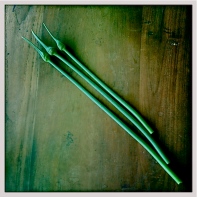Runner bean plants, the summer of 2014.
The runner bean is a sub-tropical plant, originating from central America and northern parts of South America, growing at high altitude. The Spanish brought runner beans back to Europe in the 16th century, they were introduced to Britain during the Tudor period. Originally grown in the Britain as an ornamental climber, they’re now one of the most popular vegetables grown in Britain today.
Runner beans are perennials but grown as an annual in the UK, the plants are tender and will not survive our cold winters. They are easy to grow and fairly trouble free. As climbers, they grow vertically, taking up relatively little space. Picked young and frequently, the plants provide a plentiful yield of delicious beans. Surplus beans can be simply frozen or given away to lucky friends.
Here’s how to grow runner beans:
Sow
- Sow seeds, from late April until the end of June, in individual 9cm pots, filled with seed compost, at a depth of 2 cm.
- Water well and place the pots in a propagator, placing the propagator on a sunny windowsill or place the pots in a green house.
- Germination requires the soil temperature to be above 12 degrees C (54 degrees F).
- The seeds will take about a week to germinate.
- Alternatively sow directly in the ground outdoors once any danger of frost has passed, usually around mid to late May in the UK.
Planting out
- Once germinated, the seedlings grow at quite a pace.
- Harden off the plants for a week or so before planting out.
- Runner beans plants require a support structure. Create a frame, either a wig-wam or an A-frame, for the plants to climb up.
- Runner beans prefer to grow in moist soil, so ensure a lot of moisture retentive organic matter is dug into the soil before planting out.
- Plant out once all risk of frost has pasted, usually from the end of May in the UK.
- Space the plants 9 inches to 12 inches apart for optimum yield.
- Mulch the base of the plants to help keep the roots moist.
Growing
- After planting out, the plants will rampage up the support structure
- Once the plants have reached the top of the frame, pinch out the growing tips, this will encourage the plant to grow side shoots.
- Runner beans, like all legumes, are self-fertile but they do require bees or other pollen loving insects to ‘trip’ the flowers before bean pods can set.
- Ensure the ground is kept moist, especially when the plants are in flower, and forming beans.
- Keep an eye out for slugs and snails, and aphids.
Harvest
- Pick the beans when they are about 8 inches long, and definitely before the seeds start to swell in the pod.
- Pick the beans frequently, every two to three days. This will help lengthen the cropping period.
- If beans are left on the plant for too long and the seeds in the pods start to bulge. If this happens the plant will become less productive, shortening the cropping period
Saving Seed
Saved runner bean seeds, 2014.
Last year we were given some runner bean plants from our allotment neighbour, John. Towards the end of the season we allowed some beans to go to seed. As you can see from the picture above, there’s white and purple seeds. This means that we had at least two different varieties of runner bean growing within close proximity.
Runner beans cross pollinate with other runner bean varieties very easily because bees are attracted to the brightly coloured flowers. As the bees buzz around from plant to plant they transfer pollen from one plant to another. So, if there is more than one variety of runner bean within the range of a bee, which can be up to half a mile, any seeds saved from those plants are highly unlikely to be true to the parent plant, they’re much more likely to be a hybrid.
Potential problems
- The flower may fail to ‘set’ beans pods.
There are various reasons why runner beans flower but fail to ‘set’ bean pods.
- Not enough visits from bees or other pollen loving insects. This may happen if the summer months are too cold
- Temperatures are too high: this impacts the ability of the pollen to germinate,
- The plants roots are not moist enough.
- Failure to harvest beans frequently enough.
To over come the setting problem, Tozer Seeds created the first self setting runner beans by crossing a runner bean with a climbing french bean. There are currently four self-settling runner bean varieties to choose from. Moonlight was the first, followed by Snowstorm and Stardust, all white flowered. Snowstorm and Stardust are improved versions of Moonlight. Finally there is red flowered version called Firestorm.
This year we plan to grow a traditional variety called Enorma. It has a RHS Award of Garden Merit, these beans are long and slender and have excellent flavour. We’re also going to grow one of the self setting varieties, Firestorm. It will be really interesting to see which variety yields the most, which has the best flavour and texture. We’ll keep you posted.




















Leave a comment